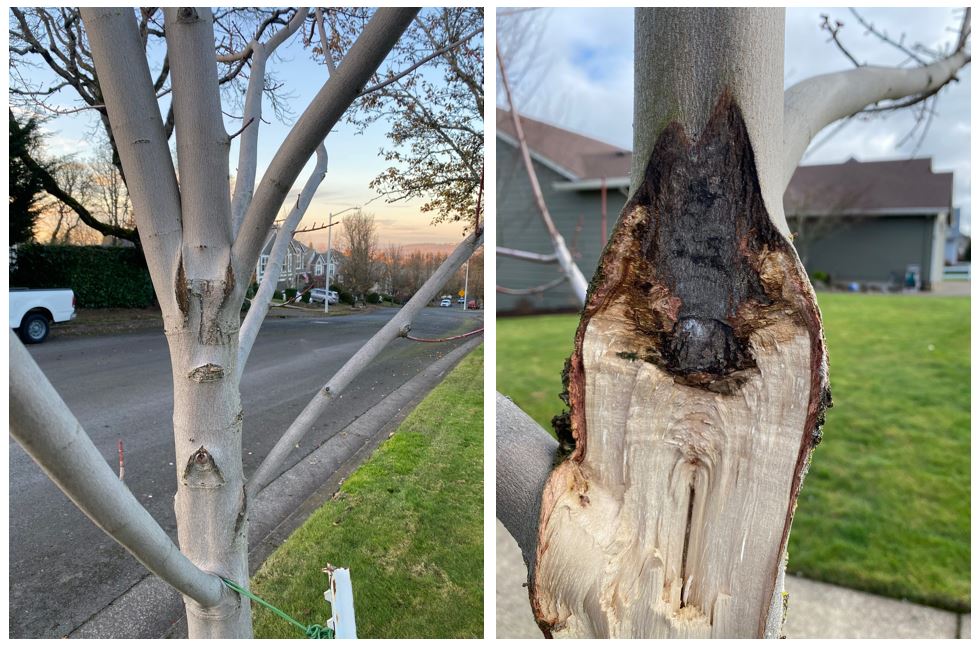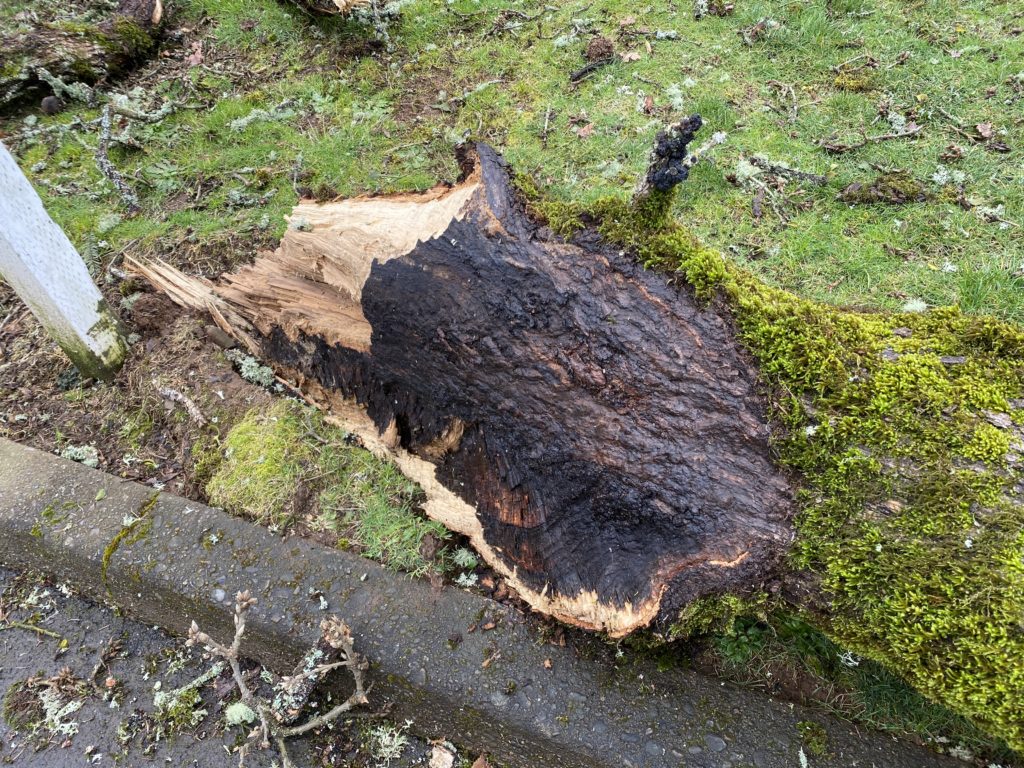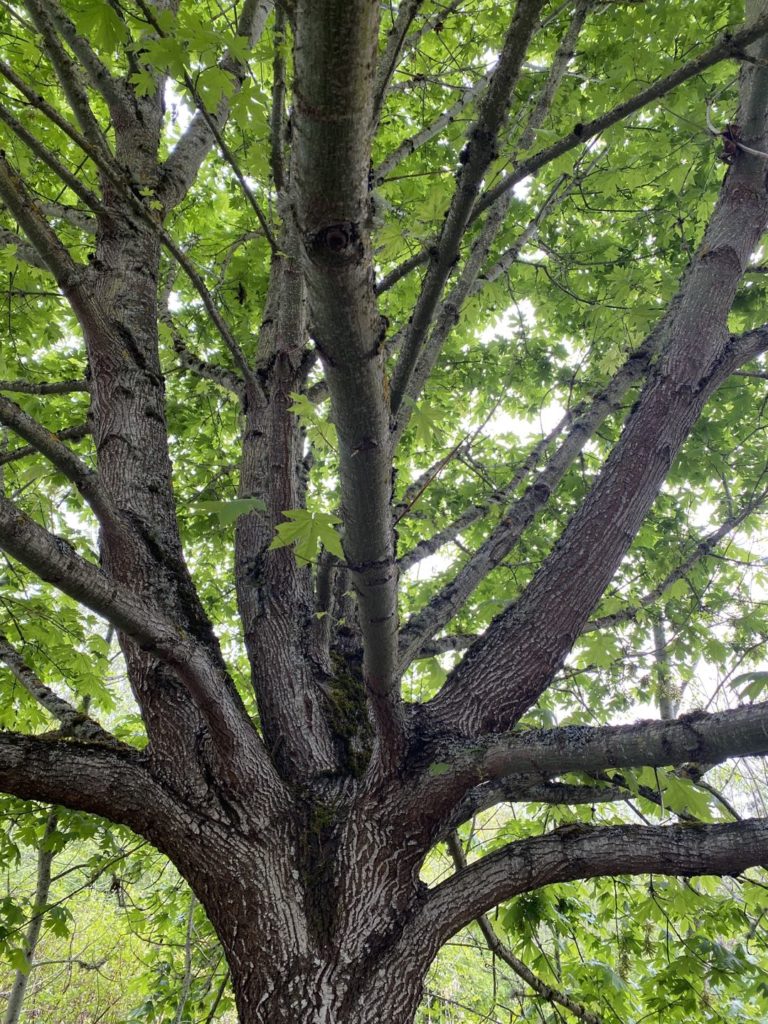The most frequent problems with trees in the urban forest and home garden are broken limbs and canopy failure. Most of these problems are avoidable with proper pruning.


Well-grown scaffold branches make a tree’s canopy safe. Their formation is critical, and they add growth to a straight trunk and well-developed root forming a safe tree. Branches are more likely to fail when they have poor attachment to the trunk. That failure matters a lot when it happens to a main branch.
The basic rules of good branch attachment aren’t hard to learn. Branches with wider angles of attachment – attached between 0 and about 45° to the trunk – the attachment has a greater chance of being weak. When the angle is tight – something greater than about 45° – branch attachment to the tree is secure. The angle of attachment is an indicator of strength. Branches don’t attach to the trunk well when the bark of the tree and branch is wedged and congested between the two. The included bark prevents the new wood from forming on the top of the branch, leaving a critical fault in the physics of the attachment. Forces like wind, ice, and snow, even gravity applied through normal growth can be too much for these weak attachments. Branches with included bark fail with much greater frequency. It’s important to watch out for branches with poor attachment to the trunk and remove them when they are young. This is especially true if the branch could become a scaffold branch.
By the time trees are planted at home or in the city most of them have a small head of branches and look like a small version of a mature tree. This isn’t ideal because they are young trees, and their structure should be quite different from that of mature trees. And neglected follow-up pruning leads to future problems.
Following planting in the early years with structural pruning is a critical piece of keeping the urban forest safe. Without management, the branches growing when the tree is purchased will become scaffold branches as the tree matures. But rarely are those early branches positioned to become the scaffold – it is very common for them to be too close, too many, too low. Keep in mind the tree you’ve planted is juvenile; it shouldn’t look mature. A young tree, even a 10’ or 15’ tall street or shade tree – is not a small version of its mature self.
After planting, allow a tree to grow with pruning toward its mature form. Envision the form, branches, height and spread the tree will take when it is mature. From that vision work backward to the existing branches, do they conform to a safe scaffold? Are they far enough off the ground? Mature trees have only a few main scaffold branches distributed up the trunk, not clustered or growing from the same point. Branches should not cross or rub. They should radiate to all areas of the canopy, like the spokes on a bike wheel. All should have wide attachment angles. If the young tree doesn’t have branches in the right spot, or has incompetent branches, plan their replacement. It’s easy because natural branch growth along the trunk will fill the canopy.
The growth of trees is governed by hormones produced in the buds at the ends of branches. These hormones control growth form, height, additional branch growth and extension, and even overall tree height. Hormones produced in the lower branches can control the growth of branches produced higher up the trunk. Using that information, you can subjugate the lower branches by pruning them back partway. Continue to keep their growth in check, allowing less growth than younger branches higher on the stem. This permits the upper branches to dominate and assume the role of scaffold. Completely removing lower branches when the tree is young isn’t a good idea because the trunk grows fatter and stronger with their presence.
Rather than a canopy that is pyramid shaped, with scaffold branches at the base, a developing tree should have a tear drop shape. Its lowest branches remain shorter than the next higher branches, for one or two layers. Keep branches growing on at least 60 percent of the trunk while the tree is young. As the tree grows, remove the branches with poor attachment. Select a few widely spaced branches to become the scaffold branches of the young tree. Once the scaffold branches are identified and the bottom of the tree’s canopy is defined, it’s safe to remove the lower branches you subjugated earlier. Direct the growth of the scaffold branches with small pruning cuts. Pruning in winter is ideal for most trees. Scaffold branches can outgrow the main stem of many deciduous trees. This often makes the tree broader than tall. Slowing their growth with some pruning does help to maintain better tree form by keeping growth heading up rather than outward.

For safety reasons it’s important to grow an urban tree with a single straight trunk. Codominant and secondary stems have included bark and tight attachment angles. These conditions both lead to unsafe trees. There is only one leader when the trunk follows a single path from the ground to the top of the tree. But there are codominant leaders if the line divides. Limit growth to a single leader with a clipper or small handsaw early while it is easy work. Do this well in advance of codominant stems maturing. It is difficult to remove an older established codominant leader and may even cause its own unsafe situation.

